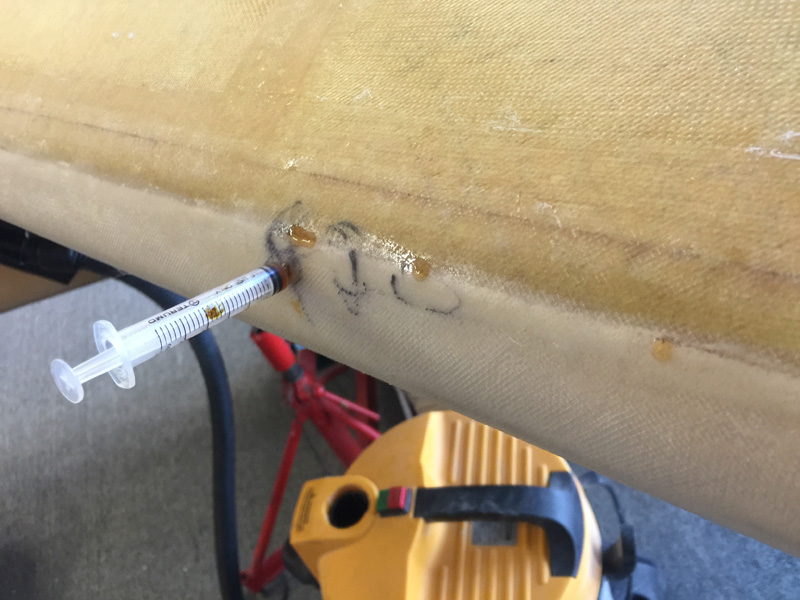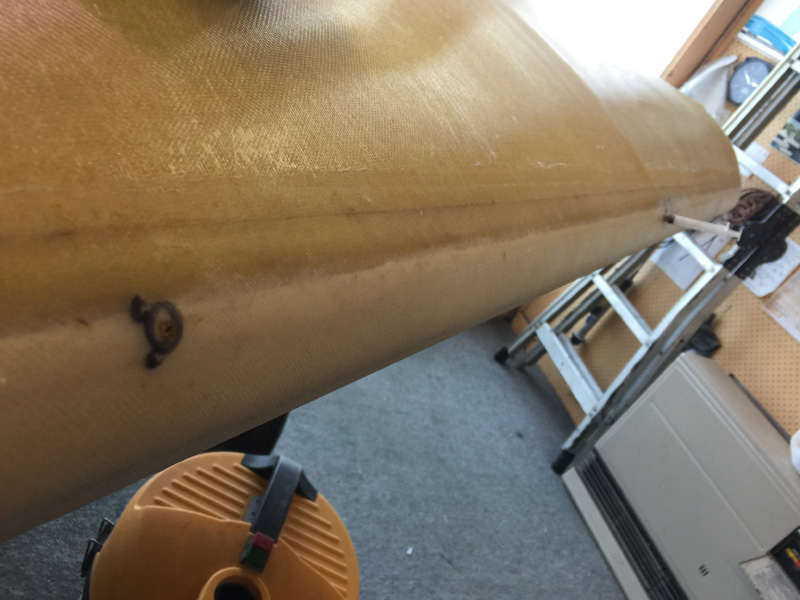| Date: 08-04-2018 | |
| Number of Hours: 8 | |
| Manual Reference: 21-5 |
After finding a couple of leaks with the aircon sniffer method, I went to work that night to plug them. While looking for these leaks I also found that the sensitive skin just above my lip and below the nose could detect air being forced out of the strakes. Once the sniffer identified the spot this was a secondary method for getting the exact leak position. It was best at 10-14″ of pressure. Below 8″ it was not noticeable.
I started with a fine needle and ended up with just a hole the size of the syringe. What seems to have happened is that I’ve had a leak somewhere between the outermost baffle and that leading edge I added later. So it was internal. This leading edge has a channel in it for the magnetometer wire. Escaping air got into the wire covering and traveled down that to a few locations on its merry way.
As you see above I’m pumping in epoxy. This is getting into the conduit and traveling along it. To encourage the flow, I’ve pulled out the drain hole stopper and have positioned my vacuum cleaner hose in such a way that it pulls about 10″ of negative pressure. This will help suck the glue into the leaking hole.
I put a LOT of glue in that hole. It came to the surface in two other places but I just held my glove over these and kept pumping in the epoxy. My next step was to use wet flox in the syringe and keep feeding it.
Where that black ring is was a secondary location. That got the same treatment.
It took a few more days and yet another aircon guy with a state of the art sniffer to find the subsequent leak that was still evident after all the work. It was very slow but I knew I still had an issue. I might mention it was with some concern too as the leak needed to be 100% resolved. No compromises here.
Well as you might expect the final leak was really hard to find. A lot of the problem was getting the testing gear and all the hoses 100% sealed so we didn’t get any more false readings. The final leak was…… at the drain hole plug. It wasn’t tight enough! My bad. The other leaks were real, this one was builder induced. Believe me, I paid for this.
That said, they two guys who helped out were fantastic. A big shout of to John M. who made several visits and Geoff E. who did the final sniffer search today. They understood that we had to get a result and it was refreshing to find professionals who were all about getting the right result and caring about the work itself.
My fall back position was to start deconstructing the strakes, starting with the leading edge. A seriously big job that fortunately was not required.
I did several hours more testing of course with my manometer and finally called the left strake good. The right one you might remember was good from the beginning. Next up was to open up the feed pipes in the sump, do a clean up and then fill it with soapy water.
I have no leaks on the bottoms and sides of the sump, or things would have been wet on the outside. Easy. Next will be a clean up and some plumbing followed by finally gluing/floxing on the sump top.
As a most relevant aside I used this test to determine the volume of the sump. I filled it to the back edge with the nose down. That water was measured as it came out as 16.8 liters. The sump could not be filled completely with the top off of course. I did some measurements and came up with my sump volume which would have to be pretty close to correct. My numbers gave me 19.6 liters which were a little conservative in the measuring. So I’m calling it 20 liters for now and it might be 20.1 or 20.2 in reality.
Sump Volume is 20 liters.



